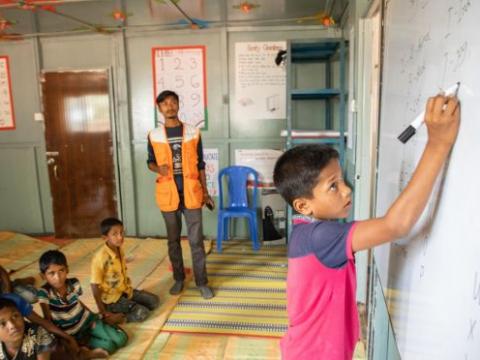Ending violence against children, one penny at a time

By Elena Gaia, Senior Advisor – Violence Against Children, World Vision
In September 2015, world leaders made a promise to children worldwide: that every child would be able to live in a world without violence by their 30th birthday.
Almost four years after world leaders agreed on the Sustainable Development Goals (SDGs), we have witnessed women and girls fight sexual violence and harassment around the world. We have also seen children campaign against weapons that turn their schools and communities into war zones.
Yet, if we look beyond the popular outrage and political declarations, is the world really putting their money where their mouth is? Are current investments from governments, donors, businesses, charities and other institutions enough for us to achieve the SDGs related to ending violence against children?
Budgeting for change
Have you ever tried tracking your spending? Maybe you spent hours logging your purchases onto a spreadsheet or one of those banking apps. Were you surprised by what you found? Did the experience change how you spent your money?
I’ve tried tracking my spending several times, and the exercise always makes me realise how much of my spending happens on auto-pilot. I see just how much money I spend on products or services that add very little to my overall life, and how little I invest in the things that are important to me.
What if we applied the same principle of tracking our spending to the institutions we interact with in our everyday lives: governments, organisations and companies? Could the simple act of tracking how they spend their resources help these institutions change the world for the better?
Budgeting to end violence against children
At World Vision, we believe tracking global investments and spending could make a difference. Tracking these is one of the main demands we’re making in our global campaign to end violence against children.
It is striking how little we know about the resources invested in protecting children from violence – a problem that is estimated to touch more than 1 billion children around the globe each year. And the little we know shows that, worldwide, we spend too little on preventing and responding to violence against children.
Out of every $100 spent globally on international aid in 2015, only 6 cents went to projects meant to end violence against children. This works out to less than US$1.1 billion. In comparison, global military expenditure was $1,739 billion in 2017, and in 2016 arms sales of the world’s 100 largest arms-producing and military services companies totalled $375 billion.
Implementing change to keep children safe from violence
We know what works to end violence against children. What we need now is for governments and organisations to invest in these projects so that we can reach all the children around the world who need protection.
Children are currently calling out for change. In places like Bangladesh and Eastern Africa, they are asking for changes to budgeting and calling out corruption in public spending.
My hope is that by 2030, no child should have to work in dangerous jobs, or experience sexual violence or conflict. My colleagues and I will be at the United Nations in New York next week discussing international spending, and reminding government officials, charities and businesses from all around the world that they need to put resources behind their promises to stop issues like child trafficking and recruitment of child soldiers.
It is only by working together that we’ll be able to keep children safe. You can find out more about our global campaign to end violence against children here or read our latest research papers about ways we, and the children we work with, think this can be achieved. Our UK office also recently analysed spending by the British government on ending violence against children, you can read the full research and if you live in the UK, sign the petition on their website calling for change.